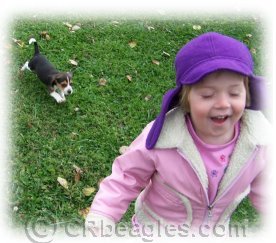|
|
(when dogs eat stools / poop) |
|
This is an awful topic, but it sometimes needs to be addressed! Coprophagy is not a breed-specific behavior. That is, beagles are not the only breed with dogs that sometimes gross out their owners by eating their own stools, or other dogs' stools. In fact, it isn't even species specific. Other animals, such as horses, hamsters, monkeys, pigs, etc., can also practice this disgusting ritual. While all breeds of dogs are susceptible to bouts of coprophagy, breeds tending to be more "anxious" are more likely to eat stools. Beagles are not considered one of these "anxious" breeds, yet some beagles participate in stool eating. Dogs may eat stools of cats, other dogs, herbivores, or some may only eat "poopsicles" (frozen poop during the winter). Possible reasons for the behavior are widely varied, from:
So, it's natural. But do we have to put up with it? Coprophagy can be reduced or eliminated. Some popular tips include:
Basically, three components of action may work together to help:
Helpful Linkshttp://www.peteducation.com/article.cfm?c=2+1551&aid=155 http://en.wikipedia.org/wiki/Coprophagia#In_dogs |
|
|
|
|
|
|
|
|
|
|
| HOME * PUPPIES FOR SALE * APPLICATION FORM * ABOUT US * GUARANTEES * SITE MAP | |
|
Last Updated |
|
"There is no psychiatrist in the world like a puppy licking your face."
-Ben Williams











